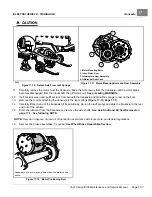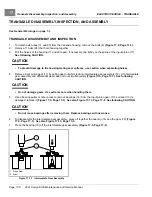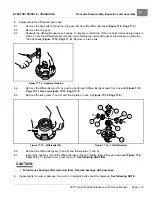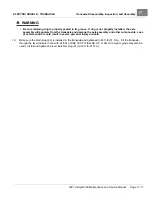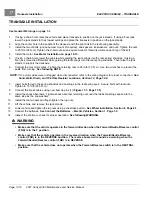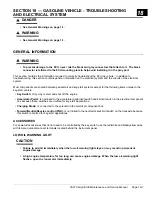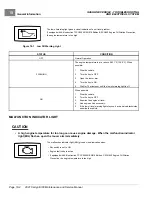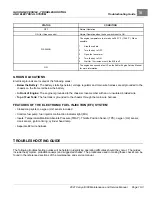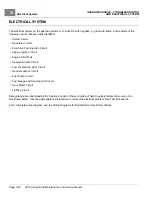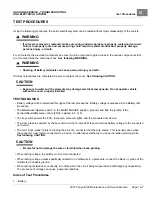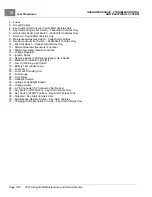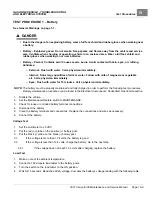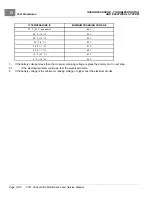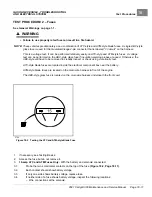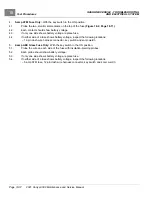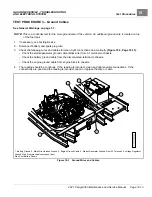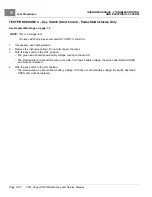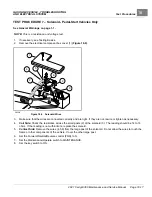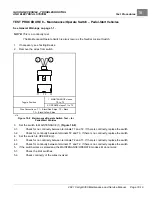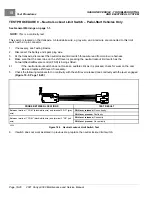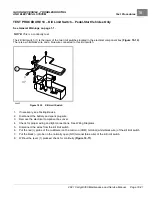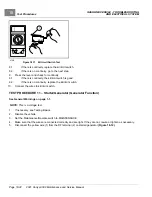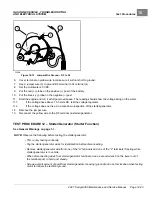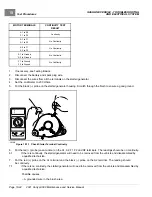
GASOLINE VEHICLE - TROUBLESHOOTING
AND ELECTRICAL SYSTEM
Test Procedures
18
TEST PROCEDURE 1 – Battery
See General Warnings on page 1-1.
DANGER
• Due to the danger of an exploding battery, wear a full face shield and rubber gloves when working near
a battery.
• Battery – Explosive gases! Do not smoke. Keep sparks and flames away from the vehicle and service
area. Ventilate when charging or operating vehicle in an enclosed area. Wear a full face shield and
rubber gloves when working on or near batteries.
• Battery – Poison! Contains acid! Causes severe burns. Avoid contact with skin, eyes, or clothing.
Antidotes:
– External: Flush with water. Call a physician immediately.
– Internal: Drink large quantities of milk or water. Follow with milk of magnesia or vegetable
oil. Call a physician immediately.
– Eyes: Flush with water for 15 minutes. Call a physician immediately.
NOTE:
The battery must be properly maintained and fully charged in order to perform the following test procedures.
Battery maintenance procedures can be found in the Electrical Components: Pedal-Start Gas Vehicle section.
1.
Disable the vehicle.
2.
Set the Maintenance/Operate switch to MAINTENANCE.
3.
Check for loose or corroded battery terminal connections.
4.
Disconnect the battery.
5.
Clean the battery terminals and connections. Replace the connections and wires as necessary.
6.
Connect the battery.
Voltage Test
1.
Set the multimeter to 20 VDC.
2.
Put the red (+) probe on the positive (+) battery post.
3.
Put the black (-) probe on the black (-) battery post.
3.1.
If the voltage is more than 12.4 volts, the battery is good.
3.2.
If the voltage is less than 12.4 volts, charge the battery. Go to the next step.
3.2.1.
If the voltage does not reach 12.4 volts after charging, replace the battery.
Load Test
1.
Make a note of the ambient temperature.
2.
Connect a 160-ampere load tester to the battery posts.
3.
Turn the switch on the load tester to the ON position.
4.
Wait for 15 seconds. Read the battery voltage. Compare the battery’s voltage reading with the following table.
2021 Carryall 300 Maintenance and Service Manual
Page 18-9
Summary of Contents for Carryall 300 2021
Page 2: ......
Page 16: ......
Page 551: ...80 2018 by Kohler Co All rights reserved KohlerEngines com 17 690 15 Rev...
Page 565: ...GASOLINE ENGINE HARNESS Wiring Diagrams Gasoline Engine Harness 26...
Page 566: ...Page intentionally left blank...
Page 567: ...GASOLINE KEY START MAIN HARNESS Wiring Diagrams Gasoline Key Start Main Harness 26...
Page 568: ...Page intentionally left blank...
Page 569: ...GASOLINE PEDAL START MAIN HARNESS Wiring Diagrams Gasoline Pedal Start Main Harness 26...
Page 570: ...Page intentionally left blank...
Page 571: ...GASOLINE INSTRUMENT PANEL HARNESS Wiring Diagrams Gasoline Instrument Panel Harness 26...
Page 572: ...Page intentionally left blank...
Page 573: ...GASOLINE FNR HARNESS Wiring Diagrams Gasoline FNR Harness 26...
Page 574: ...Page intentionally left blank...
Page 575: ...ELECTRIC MAIN HARNESS Wiring Diagrams Electric Main Harness 26...
Page 576: ...Page intentionally left blank...
Page 577: ...ELECTRIC INSTRUMENT PANEL HARNESS Wiring Diagrams Electric Instrument Panel Harness 26...
Page 578: ...Page intentionally left blank...
Page 579: ...ELECTRIC ACCESSORIES HARNESS Wiring Diagrams Electric Accessories Harness 26...
Page 580: ...Page intentionally left blank...
Page 588: ...NOTES...
Page 589: ...NOTES...
Page 590: ...NOTES...
Page 591: ...NOTES...
Page 592: ...NOTES...
Page 593: ...NOTES...
Page 594: ...NOTES...
Page 595: ......
Page 596: ......

